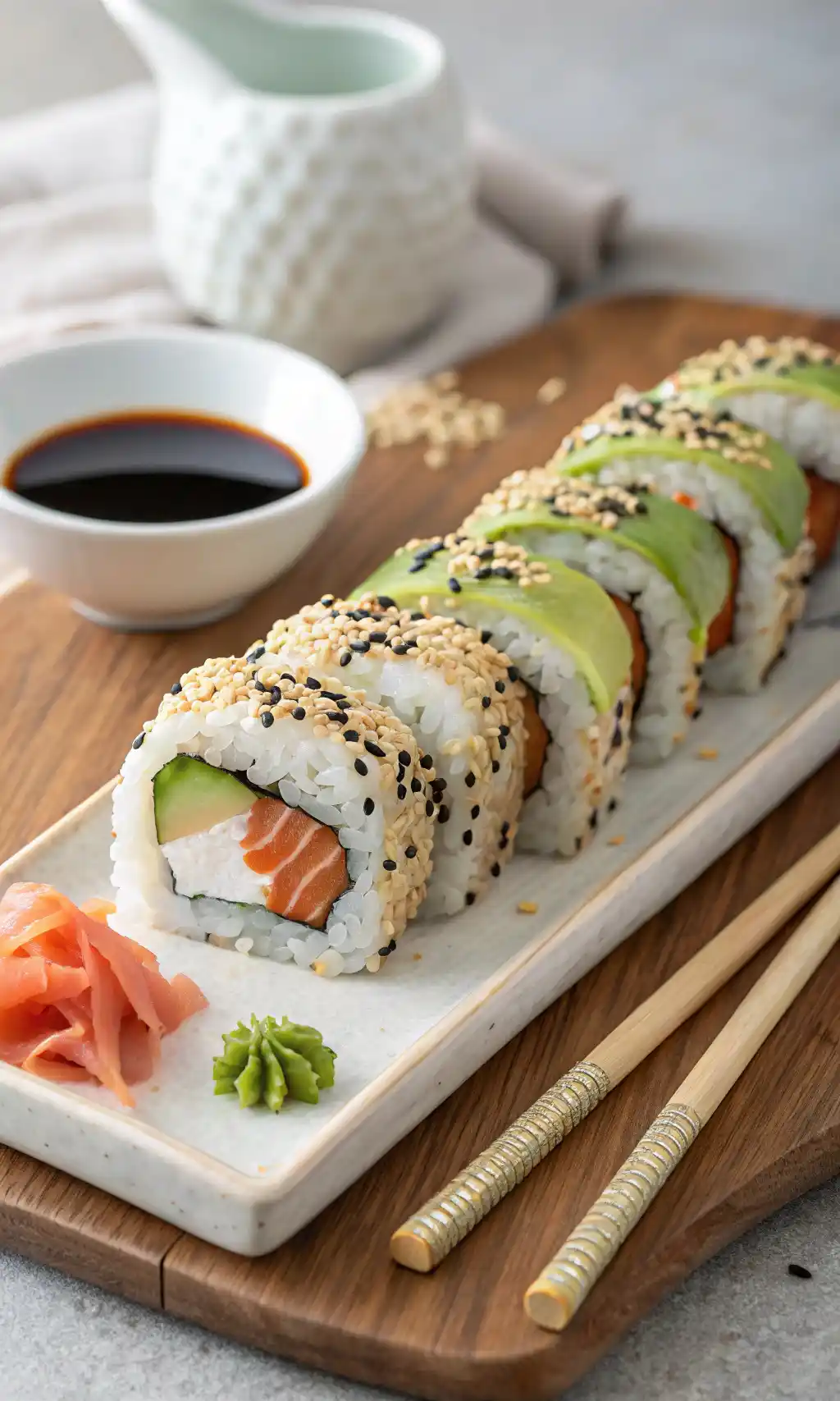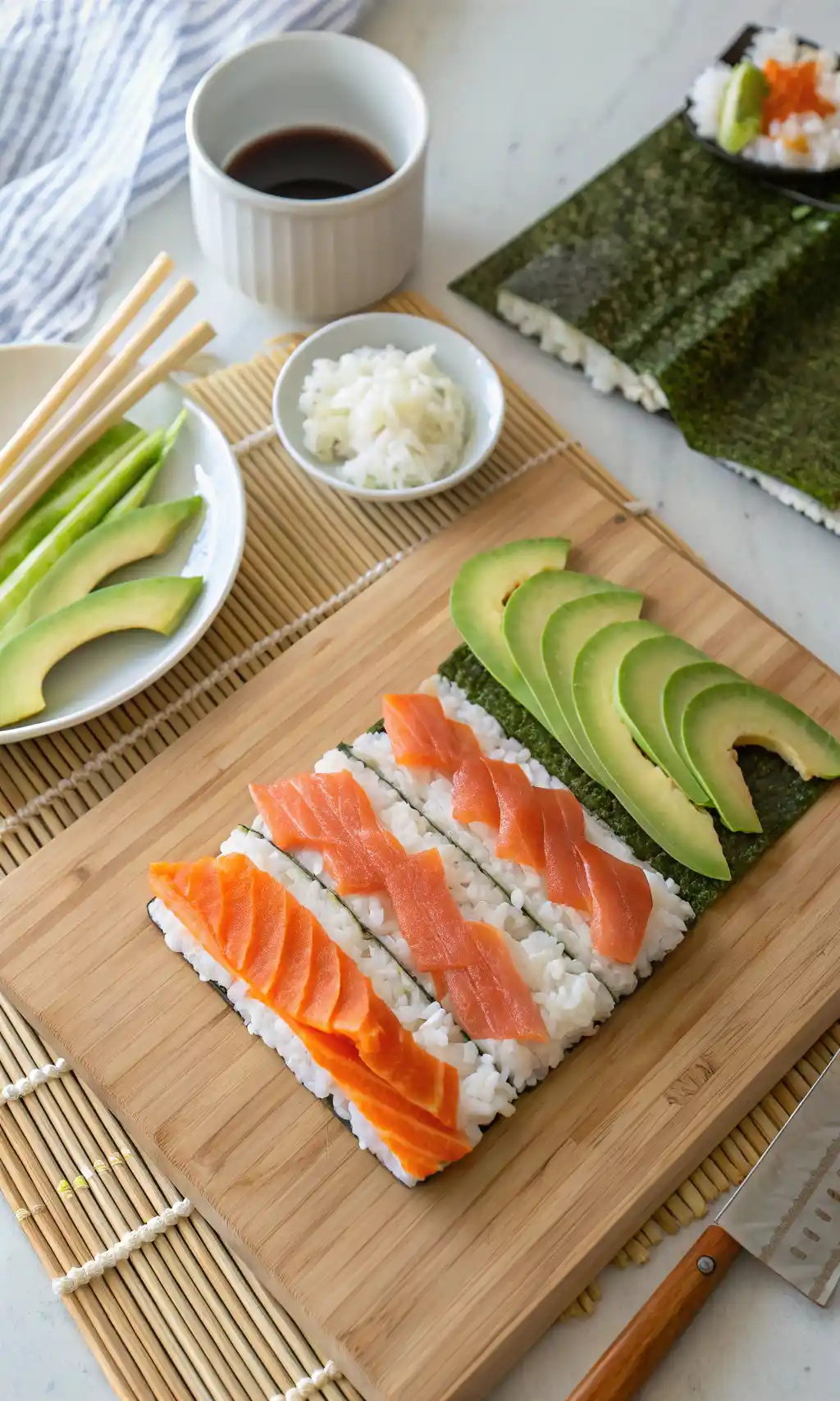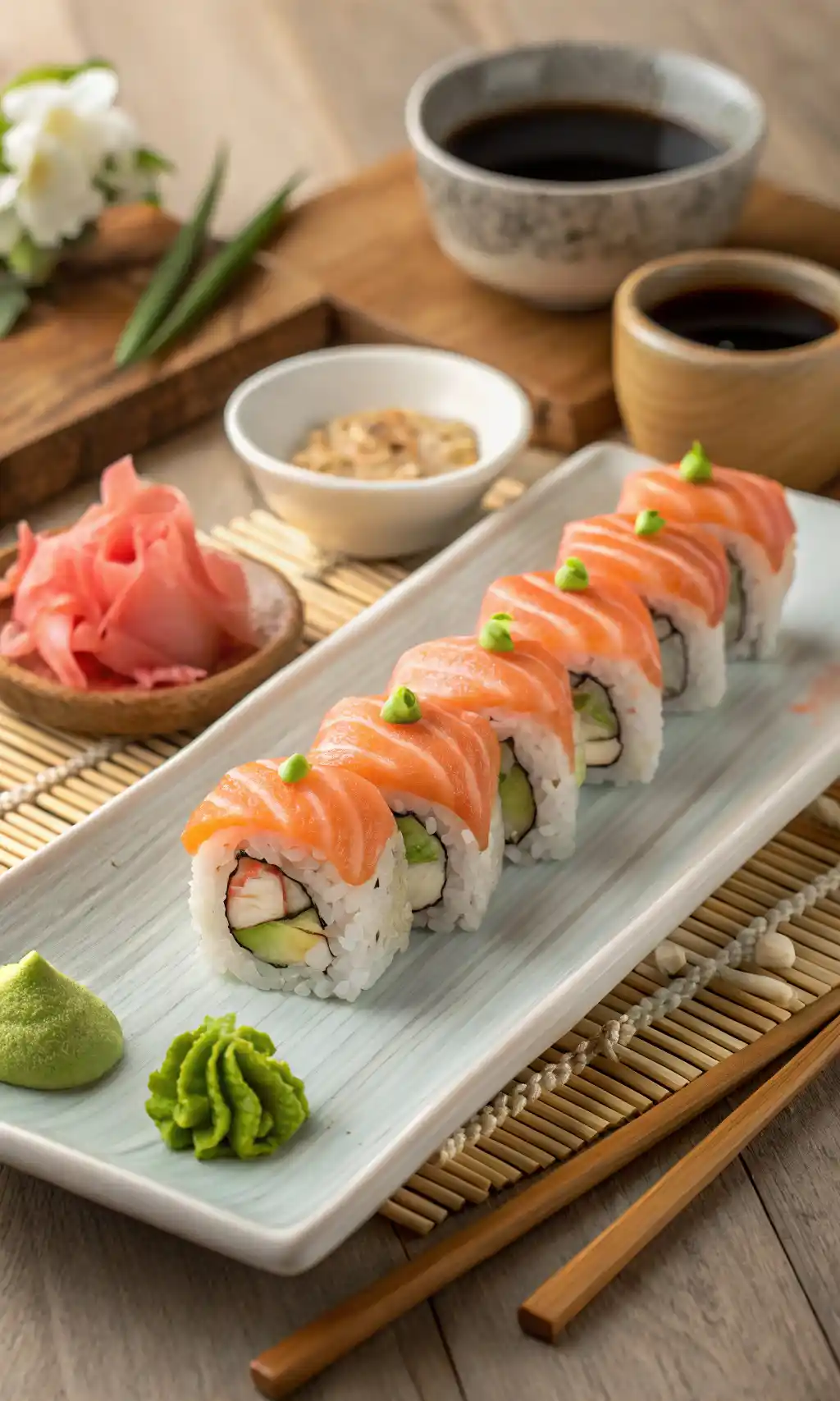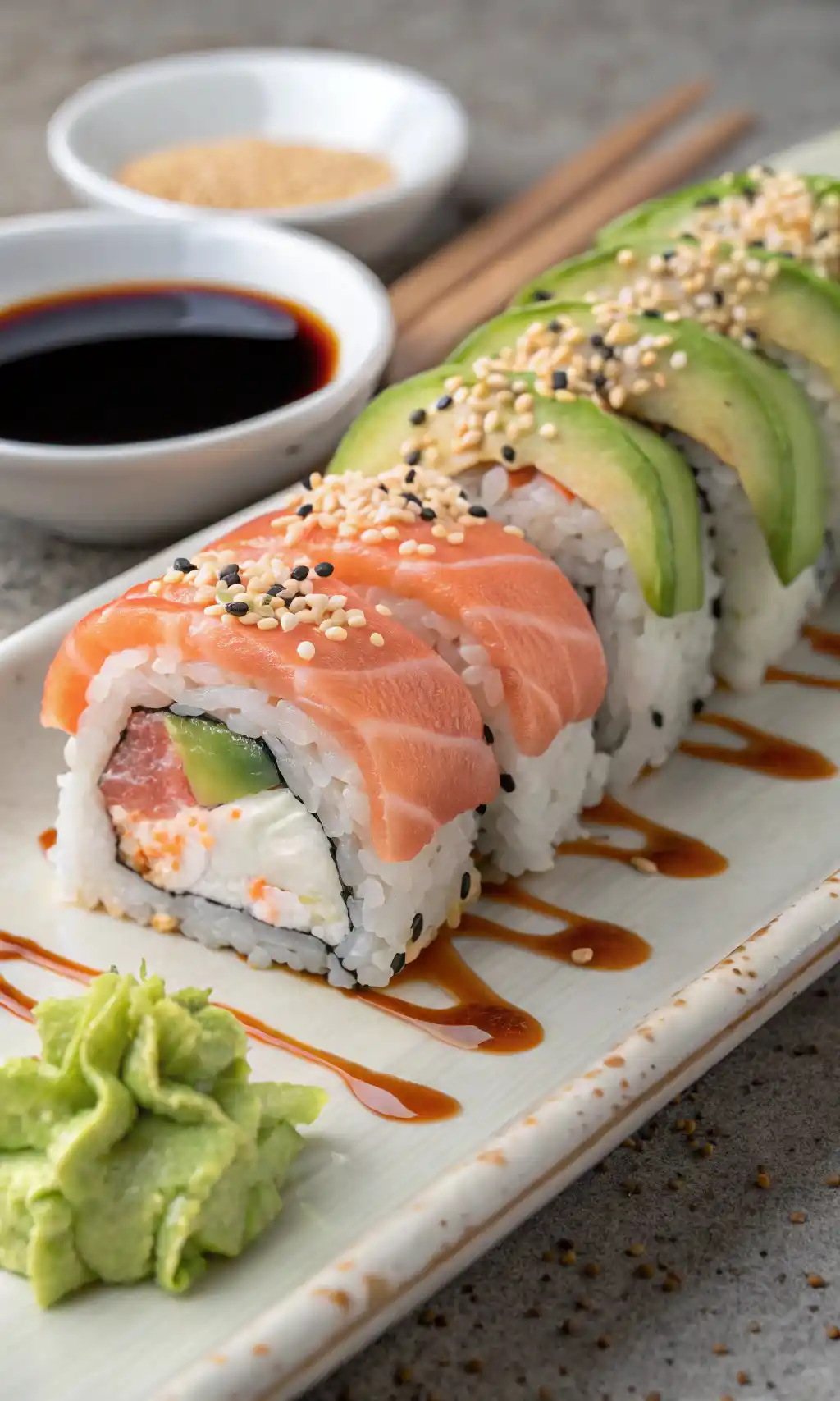Oh friends, let me tell you about my absolute obsession with this Alaska Roll! After years of spending way too much money on takeout sushi, I finally figured out how to make this creamy, salmon-topped delight right in my own kitchen. The combination of fresh salmon, buttery avocado, and that perfect crunch factor will make you feel like you’ve got your very own sushi chef hiding in the pantry! Trust me, once you nail this recipe, you’ll be hosting sushi nights that’ll have your friends begging for invites.

Why You’ll Love This Recipe
- The perfect balance of textures – creamy avocado, tender salmon, and crispy cucumber in every bite
- Looks impressively restaurant-worthy but is actually doable for home cooks (I promise!)
- Customizable with your favorite ingredients while keeping that classic Alaska Roll vibe
- More affordable than ordering delivery and so much more satisfying to make yourself
Ingredients
Sushi rice – The foundation of any good roll; short-grain Japanese rice gives you that perfect sticky texture.
Nori sheets – These seaweed wrappers hold everything together and add that distinctive oceanic flavor.
Fresh salmon – Both inside and on top! Get sushi-grade for the best flavor and food safety.
Avocado – For that buttery creaminess that makes Alaska rolls so irresistible.
Cucumber – Adds a refreshing crunch that balances the rich salmon and avocado.
Cream cheese – That tangy creaminess takes this roll to the next level.
Sesame seeds – For that nutty flavor and pretty finish.
Rice vinegar – Seasons the rice with that signature sushi tanginess.
Sugar and salt – To perfectly season your sushi rice.
Soy sauce – For dipping your beautiful creation.
Wasabi and pickled ginger – Traditional accompaniments that add heat and palate-cleansing zing.
The full ingredient list with measurements will be available in the recipe card below.
How to Make the Recipe

Step 1: Prepare the sushi rice
Rinse your rice thoroughly until the water runs clear – this removes excess starch for that perfect texture. Cook according to package directions, then transfer to a wide, non-metallic bowl to cool. While still warm, gently fold in your seasoned rice vinegar mixture (vinegar, sugar, salt). Fan the rice as you fold to create that glossy finish. Let it cool to room temperature – patience here makes rolling so much easier!
Step 2: Prep your fillings
While your rice is cooling, slice your cucumber into thin matchsticks, cut your avocado into slender wedges, and prepare thin strips of cream cheese. For the salmon, slice half into strips for the filling and the other half into thin slices for topping. Keep everything ready on a cutting board – trust me, having your mise en place ready makes the rolling process so much smoother!
Step 3: Set up your rolling station
Place a bamboo sushi mat on your work surface and cover it with plastic wrap (this prevents sticking). Put a sheet of nori shiny-side down on the mat. Have a small bowl of water nearby to wet your fingers – this prevents the rice from sticking to them.
Step 4: Roll with confidence
With dampened fingers, spread a thin layer of rice over ⅔ of the nori, leaving the top third bare. Sprinkle sesame seeds over the rice. Flip the nori so the rice side is down on the mat and the bare nori section is at the top. Along the bottom edge, arrange your salmon strips, avocado, cucumber, and cream cheese. Now for the fun part – using the mat as your guide, roll everything up from the bottom, tucking fillings in as you go. Apply gentle pressure to create a firm roll. That perfect squish is so satisfying!
Step 5: Add the topping
Place thin slices of salmon across the top of your roll, covering it completely. Cover with plastic wrap and gently press to secure the salmon. Some chefs lightly torch the salmon for extra flavor – totally optional but definitely impressive!
Step 6: Slice and serve
With a very sharp knife (dip it in water between cuts), slice your roll into 8 pieces. Arrange beautifully on a plate with wasabi, pickled ginger, and a small dish of soy sauce. Take a moment to admire your handiwork – you just made restaurant-quality sushi!
Pro Tips for Making the Recipe
Wet your knife before each cut for clean slices that don’t tear your beautiful roll.
If you’re nervous about raw fish, a “cooked” Alaska roll using smoked salmon is absolutely delicious and more approachable for beginners.
The temperature of your hands matters! Cold hands make for better sushi rolling, so run them under cool water if they’re warm.
Don’t overstuff your roll – it’s tempting to pile on the fillings, but less is more for a roll that actually stays together.
How to Serve

Arrange your Alaska Roll slices on a beautiful plate or sushi board with traditional accompaniments:
Create a wasabi “flower” with pickled ginger “petals” for a pretty presentation.
Serve with ponzu sauce as an alternative to regular soy sauce for a citrusy twist.
For a full sushi night experience, pair with miso soup and a simple cucumber salad dressed with rice vinegar.
Make it a meal with edamame, seaweed salad, and a cold Japanese beer or sake for the adults!
Make Ahead and Storage
To make ahead:
You can prepare the sushi rice up to 6 hours ahead if kept at room temperature (never refrigerate sushi rice – it gets hard and loses its lovely texture). Your fillings can be prepped a few hours ahead and kept refrigerated.
Storing leftovers:
Honestly, sushi is best enjoyed fresh, but if you must store it, wrap tightly in plastic wrap and refrigerate for no more than 24 hours. The texture will change, and it won’t be as wonderful as fresh.
Freezing:
Please don’t freeze sushi – the rice texture completely deteriorates, and the nori gets soggy. This is definitely a “make and enjoy immediately” kind of recipe!
Can I use any type of salmon for an Alaska Roll?
For the authentic Alaska Roll experience, you’ll want to use sushi-grade salmon from a reputable fishmonger or Japanese market. This salmon has been flash-frozen to kill any potential parasites and is safe to eat raw. If you’re uncomfortable with raw fish, smoked salmon makes a delicious alternative that still gives you that gorgeous Alaska Roll aesthetic. Just make sure whatever salmon you choose is the freshest possible – when it comes to sushi, quality really matters!
I’m struggling with rolling my sushi. Any troubleshooting tips?
First off, don’t worry – even sushi chefs spent years perfecting their technique! The most common issue is using too much rice or overfilling your roll. Try using a thinner layer of rice and fewer fillings until you get the hang of it. Another game-changer is making sure your bamboo mat is covered with plastic wrap to prevent sticking. And here’s my secret weapon: after placing your fillings, use your fingers to hold them in place while using your thumbs to bring up the edge of the mat. Then roll forward, applying even pressure across the roll. It’s like swaddling a baby – firm but gentle!
Can I make Alaska Rolls without a bamboo mat?
Absolutely! While a bamboo mat (makisu) does make rolling easier, you can use a clean kitchen towel or even a silicone mat in a pinch. Some of my friends even use a flexible cutting board! The key is having something that helps you apply even pressure while rolling. Just be sure to wrap whatever alternative you’re using in plastic wrap to prevent sticking. Your rolls might not be picture-perfect the first time, but they’ll still taste amazing!
What’s the difference between an Alaska Roll and a California Roll?
Great question! While they might look similar, the Alaska Roll is distinguished by having salmon on both the inside and outside of the roll, plus it typically contains cream cheese for that rich, tangy flavor. A California Roll usually has imitation crab (surimi) inside with avocado and cucumber, and often has tobiko (flying fish roe) or sesame seeds on the outside rather than fish. The Alaska Roll is generally considered more luxurious because of the real salmon. Think of the California Roll as the starter sushi and the Alaska Roll as the upgrade when you’re ready for something more indulgent!

Alaska Roll
Ingredients
Equipment
Method
- Rinse sushi rice and cook according to package directions. Season with a mix of rice vinegar, sugar, and salt while still warm. Cool to room temperature.
- Slice cucumber, avocado, salmon, and cream cheese. Set up your rolling station with a bamboo mat covered in plastic wrap.
- Place nori shiny side down. With damp fingers, spread sushi rice on 2/3 of the nori, sprinkle sesame seeds, flip over.
- Layer fillings (salmon, avocado, cucumber, cream cheese) along the bottom edge. Roll tightly using the bamboo mat.
- Top roll with thin slices of salmon. Cover with plastic wrap and gently press to secure the topping.
- Slice into 8 pieces with a wet, sharp knife. Serve with soy sauce, wasabi, and pickled ginger.





